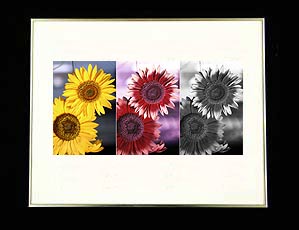High Speed and Technical Photographs / 5013Prof. Andrew Davidhazy |

|
We see colors because subjects reflect, absorb or emmit certain wavelengths of the electromagnetic spectrum. Those wavelengths we can see we call light. But subjects interact with wavelenghts that we can not see as well. In this case, a sunflower appears differently when inspected by ultraviolet wavelengths as opposed to visible ones. The flower, which seems to uniformly reflect yellow light across its petals, obviously does not reflect ultraviolet wavelengths in a similar, uniform fashion. The petals reflect less ultraviolet towards the middle of the flower than at the edges. This may be a "signaling" device the plants use to direct insects for poolination purposes. The ultraviolet record is the black and white one. The visible record is the normally colored one. The middle record shows colors resulting from the camera's colored filters transmitting unequal amounts of ultraviolet and thus causing the appearance of "spurious" colors. Visually striking but scientifically not meaningful. |